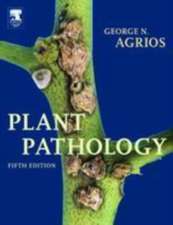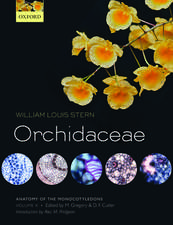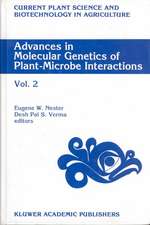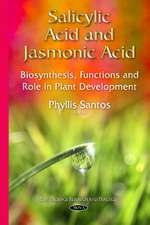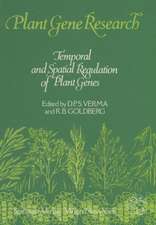Advances in Molecular Genetics of Plant-Microbe Interactions, Vol.1: Current Plant Science and Biotechnology in Agriculture, cartea 10
Editat de H. Hennecke, Desh Pal S. Vermaen Limba Engleză Hardback – 31 ian 1991
| Toate formatele și edițiile | Preț | Express |
|---|---|---|
| Paperback (1) | 1055.50 lei 38-44 zile | |
| SPRINGER NETHERLANDS – 18 dec 2010 | 1055.50 lei 38-44 zile | |
| Hardback (1) | 1232.57 lei 43-57 zile | |
| SPRINGER NETHERLANDS – 31 ian 1991 | 1232.57 lei 43-57 zile |
Din seria Current Plant Science and Biotechnology in Agriculture
-
 Preț: 414.14 lei
Preț: 414.14 lei -
 Preț: 396.78 lei
Preț: 396.78 lei -
 Preț: 396.02 lei
Preț: 396.02 lei - 24%
 Preț: 1602.93 lei
Preț: 1602.93 lei - 18%
 Preț: 1239.19 lei
Preț: 1239.19 lei - 18%
 Preț: 1234.46 lei
Preț: 1234.46 lei - 18%
 Preț: 1228.15 lei
Preț: 1228.15 lei - 18%
 Preț: 1846.58 lei
Preț: 1846.58 lei - 18%
 Preț: 955.40 lei
Preț: 955.40 lei -
 Preț: 450.88 lei
Preț: 450.88 lei - 18%
 Preț: 1228.15 lei
Preț: 1228.15 lei - 24%
 Preț: 1068.10 lei
Preț: 1068.10 lei - 18%
 Preț: 1229.28 lei
Preț: 1229.28 lei - 18%
 Preț: 1842.16 lei
Preț: 1842.16 lei - 18%
 Preț: 949.55 lei
Preț: 949.55 lei - 18%
 Preț: 1848.33 lei
Preț: 1848.33 lei - 18%
 Preț: 950.03 lei
Preț: 950.03 lei - 18%
 Preț: 955.25 lei
Preț: 955.25 lei - 18%
 Preț: 3041.41 lei
Preț: 3041.41 lei - 18%
 Preț: 1842.79 lei
Preț: 1842.79 lei - 18%
 Preț: 1838.38 lei
Preț: 1838.38 lei - 18%
 Preț: 1218.83 lei
Preț: 1218.83 lei - 18%
 Preț: 1243.78 lei
Preț: 1243.78 lei
Preț: 1232.57 lei
Preț vechi: 1503.14 lei
-18% Nou
Puncte Express: 1849
Preț estimativ în valută:
235.85€ • 246.91$ • 195.15£
235.85€ • 246.91$ • 195.15£
Carte tipărită la comandă
Livrare economică 07-21 aprilie
Preluare comenzi: 021 569.72.76
Specificații
ISBN-13: 9780792310822
ISBN-10: 0792310829
Pagini: 483
Ilustrații: XV, 483 p.
Dimensiuni: 155 x 235 x 27 mm
Greutate: 0.87 kg
Ediția:1991
Editura: SPRINGER NETHERLANDS
Colecția Springer
Seria Current Plant Science and Biotechnology in Agriculture
Locul publicării:Dordrecht, Netherlands
ISBN-10: 0792310829
Pagini: 483
Ilustrații: XV, 483 p.
Dimensiuni: 155 x 235 x 27 mm
Greutate: 0.87 kg
Ediția:1991
Editura: SPRINGER NETHERLANDS
Colecția Springer
Seria Current Plant Science and Biotechnology in Agriculture
Locul publicării:Dordrecht, Netherlands
Public țintă
ResearchCuprins
Molecular strategies in the interaction between Agrobacterium and its hosts.- Signal transduction via VirA and VirG in Agrobacterium.- The T-DNA on its way from Agrobacterium tumefaciens to the plant.- Functional organization of the regions responsible for nopaline and octopine catabolism in Ti plasmids of Agrobacterium tumefaciens.- Gene-for-gene relationships specifying disease resistance in plant-bacterial interactions.- Avirulence gene D from Pseudomonas syringae pv. tomato and its interaction with resistance gene Rpg4 in soybean.- Genes and signals controlling the Pseudomonas syringae pv. phaseolicola-plant interaction.- The hrp gene cluster of Erwinia amylovora.- Characterization of genes from Xanthomas campestris pv. vesicatoria that determine avirulence and pathogenicity on pepper and tomato.- Pectic enzyme production and bacterial plant pathogenicity.- Molecular analysis of a gene that affects extracellular polysaccharide production and virulence in Pseudomonas solanacearum.- Interactions between Arabidopsis thaliana and phytopathogenic Pseudomonas pathovars: A model for the genetics of disease resistance.- Interaction between Arabidopsis thaliana and Xanthomonas campestris.- Exopolysaccharides in the interaction of the fire-blight pathogen Erwinia amylovora with its host cells.- Iron as a modulator of pathogenicity of Erwinia chrysanthemi 3937 on Saintpaulia ionantha.- Genetic and physiological aspects of the pathogenic interaction of Clavibacter michiganense subsp. michiganense with the host plant.- DNA probes as tools for the study of host-pathogen evolution: The example of Pseudomonas solanacearum.- Overview on genetics of nodule induction: Factors controlling nodule induction by Rhizobium meliloti.- NodRm-1, a sulphated lipo-oligosaccharide signal of Rhizobium meliloti elicits hair deformation, cortical cell division and nodule organogenesis on alfalfa roots.- Rhizobium meliloti nodulation gene regulation and molecular signals.- Genetic and biochemical studies on the nodulation genes of Rhizobiumleguminosarum bv. viciae.- The biochemical function of the Rhizobium leguminosarum proteins involved in the production of host specific signal molecules.- Studies on the function of Rhizobium meliloti nodulation genes.- Genetics of host specific nodulation by Bradyrhizobium japonicum.- Signal exchange mediates host-specific nodulation of tropical legumes by the broad host-range Rhizobium species NGR234.- The use of the genus Trifolium for the study of plant-microbe interactions.- Roles of lectin in the Rhizobium-legume symbiosis.- Analyses of the roles of R.meliloti exopolysaccharides in nodulation.- The role of the Rhizobium meliloti exopolysaccharides EPS I and EPS II in the infection process of alfalfa nodules.- Regulation of nitrogen fixation genes in Rhizobium meliloti.- Complex regulatory network for nif and fix gene expression in Bradyrhizobium japonicum.- Genomic instability in Rhizobium: Friend or foe?.- Cytokinin production by rhizobia.- Molecular genetics of the hydrogen uptake system of Rhizobium leguminosarum.- ?-Glucuronidase (GUS) operon fusions as a tool for studying plant-microbe interactions.- Specificity of plant-fungus interactions: Molecular aspects of avirulence genes.- Mutual triggering of gene expression in plant-fungus interactions.- Fungal signals involved in the specificity of the interaction between barley and Rhynchosporium secalis.- Molecular determinants of pathogenesis in Ustilago maydis.- The b locus of Ustilago maydis: Molecular analysis of allele specificity.- An in planta induced gene ofPhytophthora infestans codes for ubiquitin.- Strategies for the cloning of genes in tomato for resistance to Fulvia fulva.- Downy mildew of Arabidopsis thaliana caused by Peronospora parasitica:A model system for the investigation of the molecular biology of host-pathogen interactions.- Host-pathogen interactions in the system Arachis hypogaea-Cercospora arachidicola.- Genesis of root nodules and function of nodulins.- Early nodulins in pea and soybean nodule development.- Different modes of regulation involved in nodulin gene expression in soybean.- Regulation of nodule-expressed soybean genes.- Patterns of nodule development and nodulin gene expression in alfalfa and Afghanistan pea.- Endocytosis and the development of symbiosomes in the pea-Rhizobium symbiosis.- Plant genetic control of nodulation in legumes.- Genetic and cellular analysis of resistance to vesicular arbuscular (VA) mycorrhizal fungi in pea mutants.- Agrobacterium rhizogenes T-DNA genes and sensitivity of plant protoplasts to auxins.- Chimaeras and transgenic plant mosaics: A new tool in plant biology.- Identification of signal transduction pathways leading to the expression of Arabidopsis thaliana defense genes.- Local and systemic gene activation following the hypersensitive response of plants to pathogens.- Properties of plant defense gene promoters.- Signals in plant defense gene activation.- A search for resistance gene-specific receptor proteins in lettuce plasma membrane.- Pathogenesis-related proteins exhibit both pathogen-induced and developmental regulation.- Pathogen-induced genes in wheat.- Biological activity of PR-proteins from tobacco; characterization of a proteinase inhibitor.- Molecular recognition in plants: Identification of a specific binding site for oligoglucoside elicitors ofphytoalexin accumulation.- Perception of pathogen-derived elicitor and signal transduction in host defenses.- Phosphoprotein-controlled changes in ion transport are common events in signal transduction for callose and phytoalexin induction.- Induced systemic resistance in cucumber in response to 2,6-dichloro-isonicotinic acid and pathogens.- Genetic aspects of phenazine antibiotic production by fluorescent pseudomonads that suppress take-all disease of wheat.- Secondary metabolites of Pseudomonas fluorescens strain CHA0 involved in the suppression of root diseases.- Tests of specificity of competition among Pseudomonas syringae strains on plants using recombinant ice- strains and use of ice nucleation genes as probes of in situ transcriptional activity.- Regulation of the synthesis of indole-3-acetic acid in Azospirillum.- Author Index.
Recenzii
This is an excellent book providing both overviews and current research details. It covers the increasingly broad field of the molecular genetics of plant-microbe interactions in a comprehensive manner. I would thoroughly recommend this book to anyone with an interest in the field.
Journal of Experimental Botany
' The book can be recommended to lecturers and graduate students. ' Plant breeding 108 1992
Journal of Experimental Botany
' The book can be recommended to lecturers and graduate students. ' Plant breeding 108 1992

